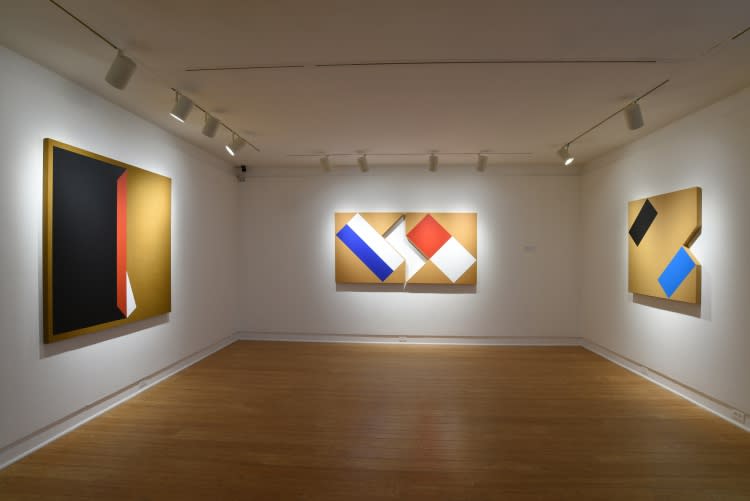May 10 2018 By their nature, retrospective shows are tricky propositions, and even more so when an artist’s career spans over five decades. Potential pitfalls abound: too much of the same, not enough of the same, not enough variety to have a coherent and measured overview, too much curatorial rationalizing—the list goes on and on. This is often compounded by the practical challenges of retrieving seminal artwork from private and public collections and of installing the material in a meaningful way (both chronologically and visually). For the artists who are still active, there is the challenge of presenting the recent work without making it appear as a mere afterthought to the earlier canonical oeuvre.
Tony DeLap’s current retrospective at the Laguna Art Museum (curated by Peter Frank) not only avoids these inherent hazards of the retrospective, but also succeeds in conveying the creative path taken by the now-nonagenarian artist. This path originates with DeLap’s early emphasis on the magic of optics and culminates with ontologically magical works made within the last five years. The LAM exhibition illustrates how the artist’s sleight of hand became increasingly complicated over his career, until he finally abandoned the magician’s panache in order to lay bare the power of object, surface, and space. The story of this progress is told by the exhibition through the clever cross-referencing of the early and the late work.
Installation view, “Tony DeLap: a Retrospective.” Photo: Laguna Art Museum.
DeLap’s aesthetic goals first come into focus in his 1960s eye-bending objects, which straddle the space between painting and sculpture. Here he seems to be going for the sublime, although not via the common shortcut of the painterly mark. His method is rooted in flawless execution of visual ambiguity. The edges of stretcher bars conjoin perfectly, matching the weave of the canvas that covers them; wooden frames twist, angle, and bend, implying movement in the monochrome surfaces they surround. Yet nothing seems fussy or superfluous. DeLap is clearly at ease with his art. He is equally comfortable with the micro scale of detail in his boxed assemblage Mona Lisa (1962) and the macro scale of the vertiginous wood-and-glass sculpture Floating Lady II (1970, 2017), which suspends disbelief. The artist, who closely oversaw the installation of the show, reiterated his visual control not only of the objects he created in the studio, but also of the aesthetic dialogue that is conducted between works within the galleries. The staggered arrangement of the 1962–63 boxed assemblages Flip Flop, Ping Pong, and Hard Edge mirrors the staggered arrangement within the pieces, while the four large-scale, oddly shaped paintings on the expansive white wall of the Steele gallery recall suprematist compositions. In both cases, separate artworks form site-specific arrangements that are meticulously calculated to interact among themselves.
It is difficult to look at DeLap’s early- and mid-career work and not to think about the paradox of embracing both Donald Judd’s specific objects in real space, and Judd’s minimalist theatricality, so objectionable to Michael Fried. But perhaps it is this inherent theatricality that keeps the artist’s work from ever being tedious and predictable. In a 1964 Artforum review, John Coplans notes the “complex visual drama” of DeLap’s boxed assemblages, as well as a “feeling of perfection,” and “visual exactitude” that they exude. And while DeLap can be methodical in his experimentation, he is never pedantic in his media choices. There is just the right amount of the unexpected: enough to intrigue, maybe even to visually destabilize the viewer, but never so much as to become gratuitously complicated. As Coplans writes, “each piece is exactly the right scale,” and everything is there for a reason: plexiglass surfaces form solid, rounded shapes; stainless steel edges confine assemblages; lacquer finishes reflect light and direct the viewer’s eye to the next relevant segment. Wood components of the paintings are not extraneous elements but instead fuse into the object, forming indispensable “frames” akin to the casing (oklad) of the Russian Orthodox icons that served as an inspiration for the white margin of Kazimir Malevich’s Black Square (1915). The latter connection is not coincidental: many of the drawings in the show directly evoke the work of Malevich, Lissitsky, and Rodchenko.
To be sure, the Russian avant-garde is a reference point for DeLap, but, in his most recent works—the 2017 Mystery Galore and Motel Surprise (both linen on aluminum and acrylic paint)—he comes close not to constructivist dogma, but to the poetry of early Suprematism. These late paintings, while as precise and articulated as the rest of the artist’s work, appear to let go not only of the theatricality (their diminutive scale suggests just that), but also of the resolved quality that magic tricks have. Instead of reassuring that the artist will always elegantly solve any visual conundrums (as the earlier work in the exhibition does), Mystery Galore embodies vulnerability in the same way Malevich’s compositions from the 1915–16 “Last Futurist Exhibition 0,10” did (the zero in the title referred to the “zero” of form). Mystery Galore provides no reassurance of the spatial safety margin in the upper right corner—the black circle precariously balances itself just millimeters away from the edge. The 2017 paintings don’t spell anything out, and they offer no easily legible metaphors. Nor do they dominate the viewer by their scale, but still, somehow, they convey the same sincere sense of the painterly zero of form Malevich’s interacting squares and circles stood for. And while it might seem as if DeLap is simply returning to his hard-edge painterly roots of the Gherkin (1961, 2017)—an early painting mentioned by John Coplans—the latest paintings carry the self-assured simplicity lacking in that work, but plentifully evident in the late cycles of Monet, mature self-portraits of Rembrandt, and post-1895 mountains of Cézanne. Malevich referred to it as “the creation of intuitive reason.”

